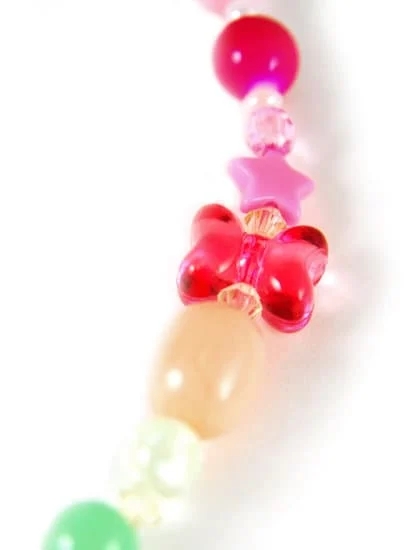Are you looking to add a touch of elegance and creativity to your accessories? If so, learning how to make beaded jewelry with elastic is a skill worth mastering. The versatility of elastic makes it an ideal choice for creating stunning bracelets and necklaces that are both stylish and comfortable to wear. In this article, we will explore the beauty of beaded jewelry with elastic, covering everything from selecting the right beads to troubleshooting common issues.
When it comes to making beaded jewelry with elastic, having the right tools and materials is essential. From beads of different sizes and shapes to high-quality elastic cord, there are several key elements required for successful jewelry making. Additionally, understanding how to choose the right beads for your projects can greatly impact the overall look and feel of your finished pieces.
Whether you prefer classic designs or enjoy experimenting with unique patterns and color combinations, there is no shortage of inspiration when it comes to designing beaded jewelry. By exploring various ideas and trends in the world of beadwork, you can unlock endless possibilities for creating one-of-a-kind accessories that reflect your personal style.
Stay tuned as we delve into the step-by-step process of stringing beads on elastic, adding charms and accents, troubleshooting common issues, and securing your finished jewelry pieces. Get ready to unleash your creativity and discover the joy of making beautiful beaded jewelry with elastic.
Getting Started
When it comes to making beaded jewelry with elastic, there are a few essential tools and materials that you will need to have on hand. First and foremost, you will need elastic cord that is specifically designed for jewelry making.
This type of elastic is strong enough to hold the weight of the beads while still being flexible enough to easily stretch over your wrist or head. You will also need a pair of scissors for cutting the elastic cord to the desired length.
In addition to the elastic cord, you will also need a variety of beads in different shapes, sizes, and colors. Beads can be made from glass, plastic, wood, metal, or even gemstones, so the options are truly endless.
It’s important to select beads that are uniform in size if you want a more polished look, but mixing different bead sizes can also create an interesting texture. Lastly, you may want to have some additional accent pieces such as charms or pendants to add extra flair to your beaded jewelry.
To keep your beading organized and efficient, it is helpful to have a designated workspace with a flat surface where you can lay out your materials. Small bowls or containers can also be useful for keeping your beads separated and easily accessible while working on your jewelry projects.
| Tools | Materials |
|---|---|
| Scissors | Elastic cord |
| Bead reamer (optional) | Assorted beads (glass, plastic, wood, metal, gemstone) |
| Pliers (optional) | Charms or pendants |
Choosing the Right Beads
Beaded jewelry made with elastic is not only beautiful but also versatile and easy to wear. When it comes to choosing beads for elastic jewelry, there are a few tips that can help you create stunning pieces that are both functional and stylish.
One important factor to consider when selecting beads for elastic jewelry is the size of the beads. Smaller beads are generally better suited for elastic as they allow for more flexibility and movement, making the jewelry more comfortable to wear. Additionally, smaller beads are less likely to cause strain on the elastic, reducing the risk of breakage.
Another consideration when choosing beads for elastic jewelry is the material of the beads. While a wide variety of materials can be used, such as glass, metal, or gemstone beads, it’s important to ensure that the beads have smooth edges to prevent them from cutting into the elastic over time. It’s also worth noting that lighter weight beads are preferable for elastic jewelry as they place less stress on the elastic.
Lastly, consider the color and texture of the beads when creating beaded jewelry with elastic. Mixing different colors and textures can add depth and visual interest to your pieces. Bead patterns can also be used in conjunction with different sizes and shapes of beads to create unique designs.
By keeping these tips in mind when choosing beads for your elastic jewelry projects, you can create beautiful and durable pieces that will be enjoyed for years to come.
| Factors | Tips |
|---|---|
| Bead Size | Choose smaller beads for flexibility and comfort |
| Bead Material | Ensure smooth edges and lighter weight to reduce stress on the elastic |
| Color and Texture | Mix different colors and textures for visual interest |
Design Inspiration
Color Combinations and Patterns
When it comes to creating beaded jewelry with elastic, the possibilities are endless. One popular trend is to experiment with different color combinations and patterns. Consider using complementary colors or even mixing various shades of the same color to create a vibrant and eye-catching piece. You can also play around with patterns such as stripes, chevron, or ombre effects to add visual interest to your jewelry.
Nature-Inspired Designs
Nature-inspired designs have been increasingly popular in beaded jewelry making. Incorporating floral motifs, leaf shapes, or even using natural materials like wood beads can lend a rustic and organic feel to your creations. Take inspiration from the beauty of the natural world and infuse elements of nature into your beaded jewelry designs.
Personalization and Customization
Another trend in beaded jewelry design is personalization and customization. Whether it’s incorporating initials, birthstones, or symbolic charms, adding personalized touches to your elastic jewelry can make it more meaningful for both the creator and the wearer. Consider incorporating meaningful symbols or messages into your designs to create unique and personalized pieces.
As you explore these design ideas and trends, remember that there are no rules when it comes to making beaded jewelry with elastic. Let your creativity guide you as you experiment with different techniques, colors, and embellishments to create stunning pieces that reflect your personal style and individuality.
Step-by-Step
Gathering Your Materials
Before you begin stringing beads on elastic for your bracelets or necklaces, make sure you have all the necessary materials. You will need elastic cord, beads of your choice, scissors, and a ruler. It’s important to choose an elastic cord that is strong enough to hold the weight of your beads and stretchy enough to easily slide over your hand or head.
Preparing the Elastic Cord
The first step in stringing beads on elastic is cutting a piece of cord to the desired length. Keep in mind that for bracelets, you’ll want to add a little extra length to accommodate the thickness of the beads and allow for stretching over your hand. For necklaces, consider how long you want the finished piece to be and add a few extra inches for tying off the ends.
Next, it’s helpful to secure one end of the elastic cord with a knot or using a bead stopper. This will prevent your beads from sliding off as you string them onto the cord.
Stringing Beads Onto the Elastic
Once your elastic cord is prepared, it’s time to start adding beads. Begin by selecting your first bead and carefully threading it onto the elastic cord. Continue adding beads in the desired pattern or design, making sure they are snugly but not too tightly strung together.
Take care when working with smaller beads or those with irregular shapes, as they may require extra attention to ensure they are properly secured on the elastic cord.
As you continue adding beads, periodically check that they are evenly distributed along the length of the cord and adjust as needed. This will help ensure a balanced and attractive final product.
By following these steps on how to make beaded jewelry with elastic, you can create beautiful and versatile pieces that are easy to wear and enjoy. Whether you’re making bracelets or necklaces for yourself or as gifts for others, mastering this technique opens up endless possibilities for expressing your personal style and creativity through beaded jewelry.
Adding Charms and Accents
When it comes to making beaded jewelry with elastic, adding charms and accents can take your creations to the next level. Whether you’re making bracelets or necklaces, incorporating charms and accent beads can add personality and flair to your designs. Here are some tips on how to enhance your beaded jewelry with these special touches:
1. Choose the right charms: When selecting charms for your beaded jewelry, consider the theme or style of your design. For example, if you’re making a nature-inspired bracelet, you might choose leaf or flower charms. If you’re creating a beach-themed necklace, seashell or starfish charms would be a perfect fit.
2. Add accent beads: Accent beads are another way to elevate your beaded jewelry with elastic. These small beads can complement your main beads and provide visual interest to your design. Consider using metal spacer beads, sparkling crystals, or unique shaped beads to add texture and dimension.
3. Placement matters: When adding charms and accent beads to your beaded jewelry, think about where you want them to be positioned. You can scatter them throughout the design for a balanced look, or concentrate them in one area as a focal point. Experiment with different placements to see what works best for your design.
By incorporating charms and accent beads into your beaded jewelry with elastic, you can create unique, eye-catching pieces that reflect your personal style and creativity. Don’t be afraid to experiment with different combinations and placements to find the perfect balance for your designs. With these tips in mind, you’ll be able to enhance your beaded jewelry with charming accents that make a statement.
Troubleshooting
When working with elastic for beaded jewelry, it’s not uncommon to encounter a few issues along the way. Whether it’s the elasticity of the cord, bead alignment, or securing the knots, troubleshooting these common problems can help ensure that your beaded jewelry turns out beautifully.
Here are some common issues and solutions when working with elastic for beaded jewelry:
1. Elasticity: One common issue when working with elastic is its tendency to lose its stretch over time. To prevent this, choose high-quality elastic cord that is specifically designed for jewelry making. Additionally, avoid overstretching the cord during the stringing process, as this can lead to premature wear and tear.
2. Bead Alignment: Another issue you might encounter is beads shifting or not aligning properly on the elastic cord. To avoid this problem, consider using spacer beads in between larger beads to help maintain even spacing and alignment.
3. Securing Knots: Tying off elastic cords can also be tricky, as they tend to slip and come undone if not secured properly. One solution to this issue is to use a surgeon’s knot when tying off the ends of your beaded jewelry. This type of knot provides extra security and reduces the likelihood of your bracelet or necklace coming apart unexpectedly.
By taking these common issues into consideration and implementing these solutions, you can troubleshoot any challenges that arise while making beaded jewelry with elastic. With a bit of patience and practice, you’ll soon be creating beautiful and durable pieces that will stand the test of time.
Finishing Touches
When it comes to making beaded jewelry with elastic, the finishing touches are just as important as the design and bead selection. Securing and finishing your beaded jewelry with elastic not only ensures durability and longevity but also adds a professional touch to your creations. In this section, we will delve into the essential steps and techniques for securing and finishing your elastic beaded jewelry.
One of the key aspects of finishing your elastic beaded jewelry is tying off the elastic. After stringing all your beads, it’s crucial to secure the elastic to prevent the beads from coming loose. The most common method for tying off elastic is using a surgeon’s knot, which involves making two loops before pulling the ends through.
This creates a secure and tight knot that will keep your beads in place. Be sure to trim any excess elastic for a neat finish.
Another important aspect of finishing your beaded jewelry with elastic is adding closure components. Depending on whether you are making a bracelet or necklace, you can use clasps, toggles, or even simple knots to secure the ends of the elastic. It’s essential to choose closure components that not only complement the design but also provide ease of wear for the wearer. This final step adds both functionality and aesthetic appeal to your beaded jewelry.
Lastly, consider adding a dab of clear-drying glue to the knots for extra security. This precaution can prevent accidental unraveling or slippage of the knots over time, especially with frequent wear. Additionally, applying glue can help maintain the integrity of your beaded jewelry with elastic when exposed to moisture or everyday wear and tear.
In summary, securing and finishing your beaded jewelry with elastic is an essential part of the creative process. By mastering these techniques, you can ensure that your creations are not only visually appealing but also durable and long-lasting. Paying attention to these final touches will elevate your elastic beaded jewelry-making skills and leave you with stunning pieces that stand the test of time.
Conclusion
In conclusion, embracing the versatility of beaded jewelry with elastic opens up a world of creative possibilities for jewelry makers. The use of elastic in jewelry-making allows for ease and flexibility, making it ideal for both beginners and experienced crafters. By following the steps outlined in this article and experimenting with different beads, designs, and accents, anyone can create beautiful and unique bracelets and necklaces that reflect their personal style.
Learning how to make beaded jewelry with elastic also provides a rewarding outlet for self-expression. Whether you prefer simple and classic designs or bold and colorful creations, the options are endless when it comes to elastic beaded jewelry. Additionally, the ability to troubleshoot common issues when working with elastic ensures that your finished pieces will be durable and long-lasting.
By exploring design inspiration and keeping up with current trends in beaded jewelry, you can continue to expand your skills and create stunning pieces that stand out. The finishing touches are just as important as the initial steps in beaded jewelry making, so take the time to secure your creations properly for a polished final result. With patience, practice, and a bit of creativity, anyone can master the art of making beaded jewelry with elastic.
Frequently Asked Questions
What Is the Strongest Elastic for Beaded Bracelets?
The strongest elastic for beaded bracelets is usually a high-quality stretch cord made from strong and durable materials like nylon or silicone. These materials are known for their ability to withstand the tension and stretching that comes with wearing beaded bracelets.
How Do You Tie Elastic String So It Stays?
To tie elastic string so it stays, you can use a surgeon’s knot or a square knot. These knots are known for their ability to hold elastic securely without slipping or unraveling, ensuring that your beaded bracelet stays intact and secure.
What Do You Need to Make Elastic Bead Bracelets?
To make elastic bead bracelets, you will need beads of your choice, high-quality elastic cord, scissors to cut the cord to the desired length, and a sturdy surface to work on. It’s also helpful to have a bead stopper or tape to prevent the beads from slipping off the cord as you work on your bracelet.
With these simple supplies, you can create beautiful and stylish elastic bead bracelets.

Welcome to my jewelry blog! My name is Sarah and I am the owner of this blog.
I love making jewelry and sharing my creations with others.
So whether you’re someone who loves wearing jewelry yourself or simply enjoys learning about it, be sure to check out my blog for insightful posts on everything related to this exciting topic!





